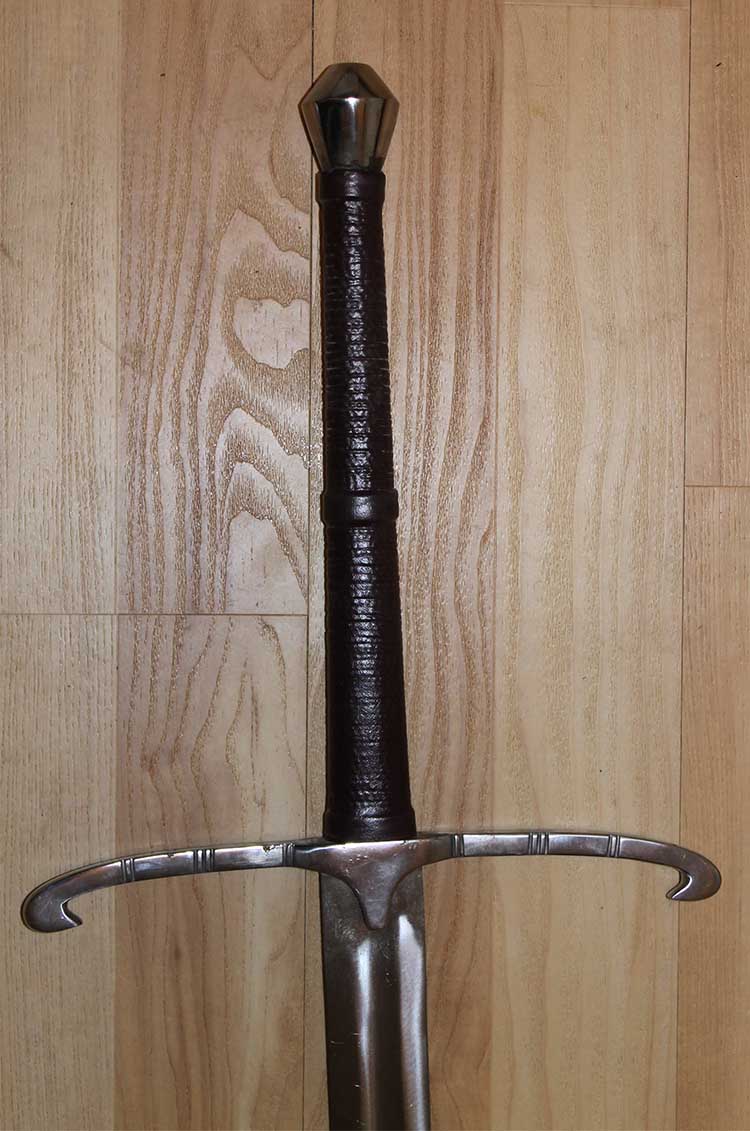Recent Articles
-
Christmas Sword Buying Guide 2025
Dec 03, 25 10:53 PM
Windlass Wallace Sword Replica - the Hero Warsword
DISCONTINUED
This sword has been discontinued and is no longer in production or available, but is preserved on the site for informational purposes.
It's actually a replica of the 'Wallace Sword' - a massive two handed blade on display at the Kelvingrove Museum..
But you would be forgiven by looking at it that it is some type of fantasy piece straight out of a Frazetta painting..

At nearly five and half feet in length, the blade alone is longer than most other two handed swords, and makes an arming sword look like a toothpick by comparison..
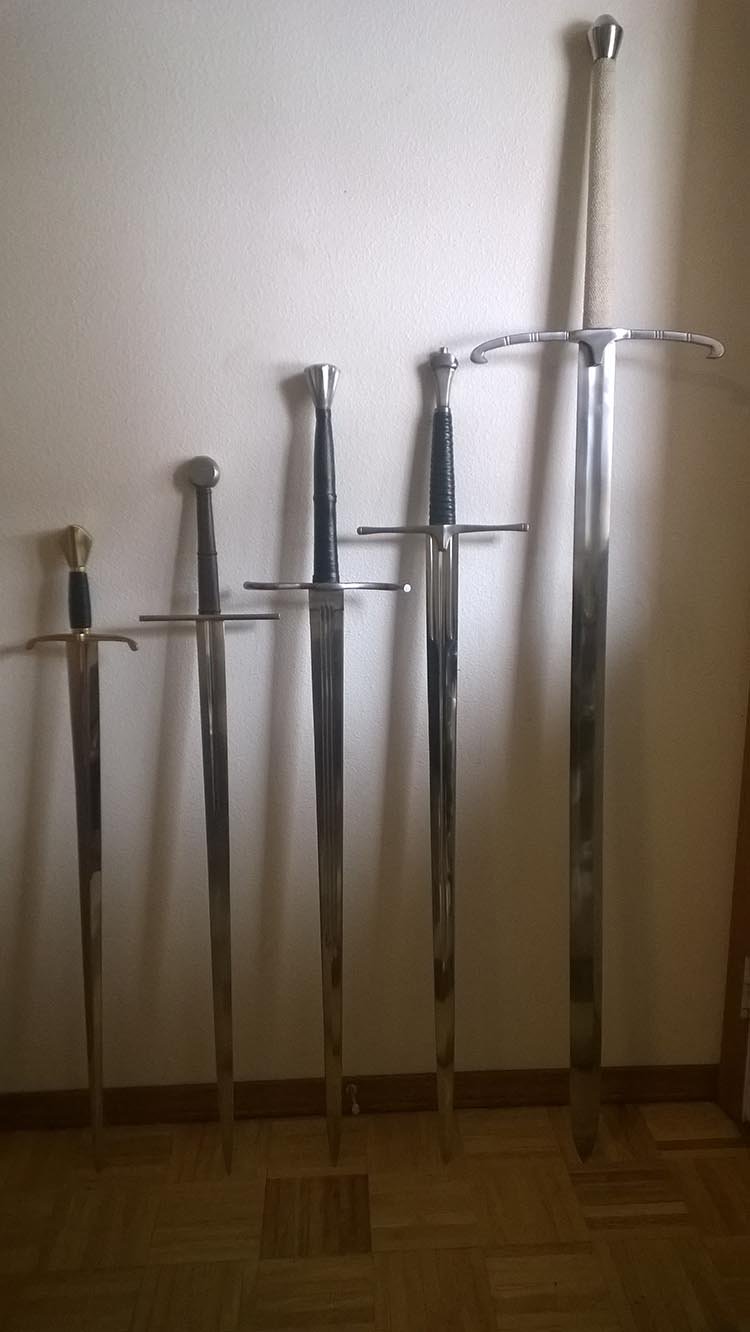 64" of glorious sword
64" of glorious swordAt nearly double the size of a one handed sword, it would be no surprise if this replica Wallace Sword by Windlass Steelcrafts was double the price. But it's not - you can pick it up for as low as just $256! Too good to be true? Let's take a close look and find out!
Windlass Hero Sword Review
Review by David McCall, Idaho, USA
I’ve been wanting a Greatsword type for quite some time and decided to bite at the Windlass Hero’s Warsword last week. It’s a pretty big sword and from what I can tell it will be a pretty fun sword to review as well as one that seems to be carrying a lot of intrigue from the community, please enjoy.
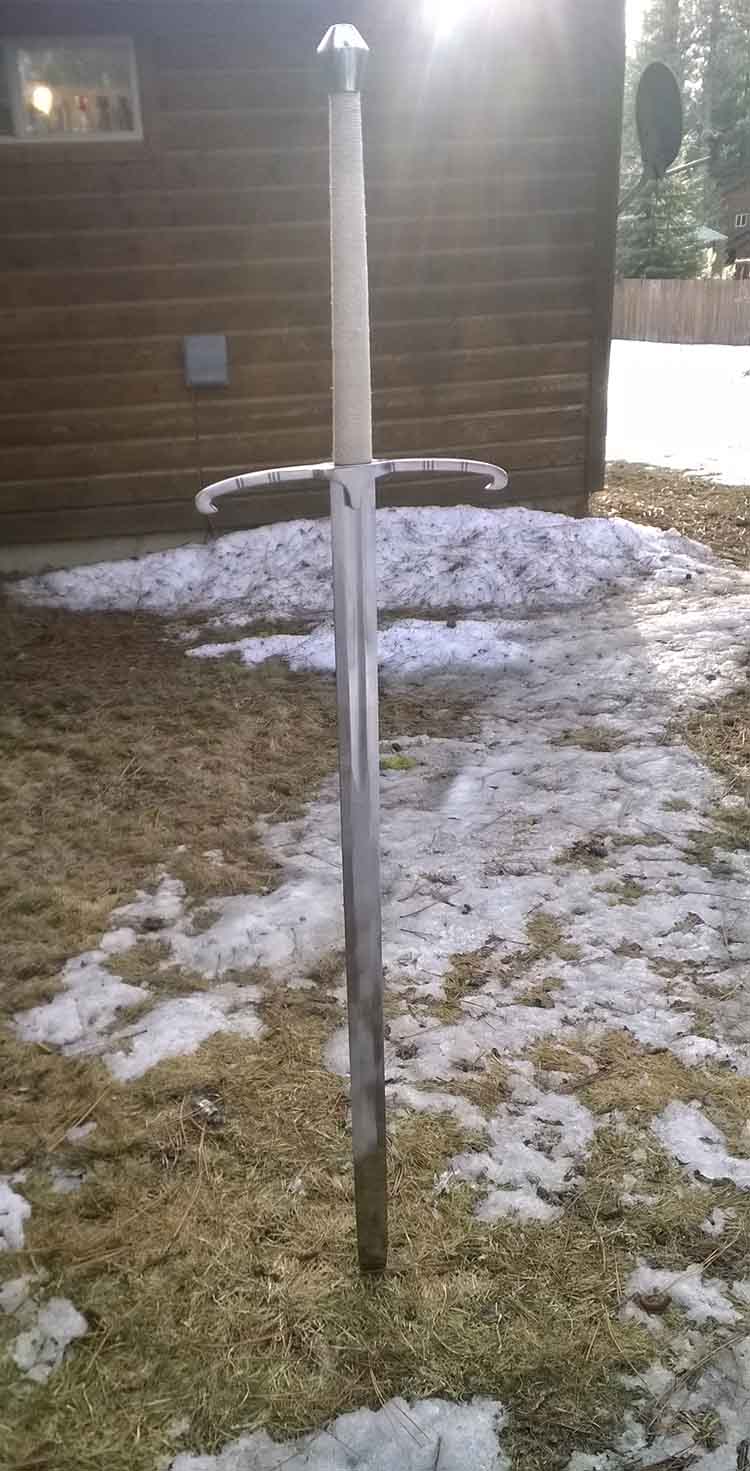
Historical Overview
Historically this sword categorizes as a Scottish Lowland Claymore. A massive sword used by 14 and 15th century Scotsman to break through front lines and dismember anything that stood in their way.
The Claymore
is a unique sword with a unique blade type that doesn’t really fit into
the commonly used Oakeshott Typology most swords are referenced by.
Having either a broad lenticular blade like a Type XIII or a broad
Hexagonal blade like a XXII.


With the majority of historical examples having the latter with either a deep fuller running half way down the blade. With some accompanied by two short fullers reaching the end of the riccasso, similar to other type XIX , XX or XXII blades.
These
swords were meant to be big deadly cutters, with long broad blades as
well as long handles allowing a controlled powerful wide spaced grip.
The guards were normally thin and long, with upturned quillions. Some
having hilt rings in the later models. Having such a presence and
capability meant anything unfortunate enough to get in it’s range would
surely be cut in two.
This sword is described as a production
replica of a Lowland Claymore believed to be used by Robert the Bruce/
Robert I of Scotland. Though the design is very similar to one
believed to be used by Sir. William Wallace too. The original it’s
supposedly based on can be viewed at the Kelvingrove Museum, with the
Wallace sword being housed in the Wallace Monument.
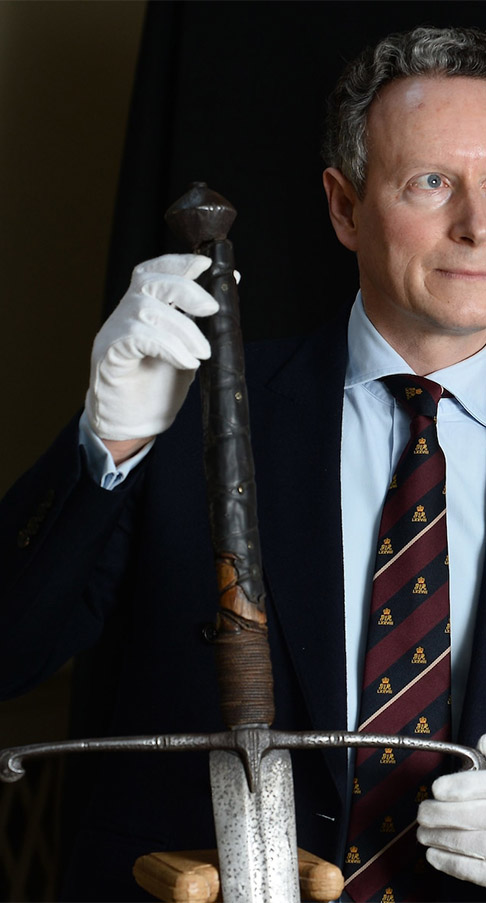
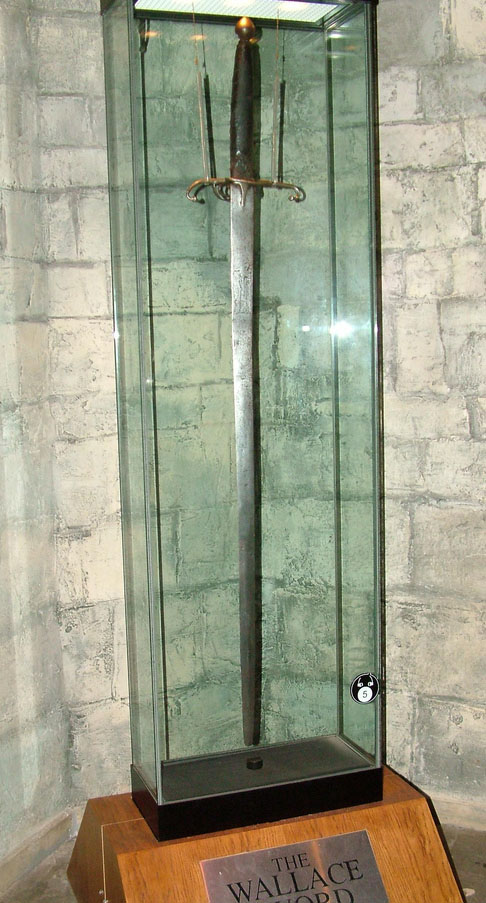
Whether it was or not is up to the historians as it’s also argued that the Claymore wasn’t used until the mid to later 15th century. Having been believed to be inspired by the Nordic Greatsword of that time. Since Robert and William lived in the later 13th to early 14th century there’s a small possibility that Claymores specifically wouldn’t have been in use during their time.
Unfortunately there are very few historical examples dating
back to their time to prove such arguments. Aside from the ones
mentioned above which are up to debate to this day due to them being
rebuilt with furniture from the 15th century.
There are a few
pieces of artwork that show the 13th century Scotsman using the
Claymore. Though it’s well known many pieces of historical artwork tend
to have overtones of the artist’s present period of arms and can lack
correct historical accuracy. None the less whether this sword was either
Robert’s, William’s or neither. The Lowland Claymore was a unique and
powerful sword earning both fear and respect on the battlefield.
Initial Impressions

So as far as packaging goes, MRL is in top form. The sword came in a large single box, the sword was wrapped in bubble wrap and heavy paper fitted around the sword. I could use the blade paper as a scabbard its so well formed. The sword was also wrapped in plastic with the handle wrapped in foam underneath the plastic. Great packaging. Unlike other shipments from MRL, the sword didn’t come with the usual catalogues and DVD. But it did come with a neat little black MRL tote bag.
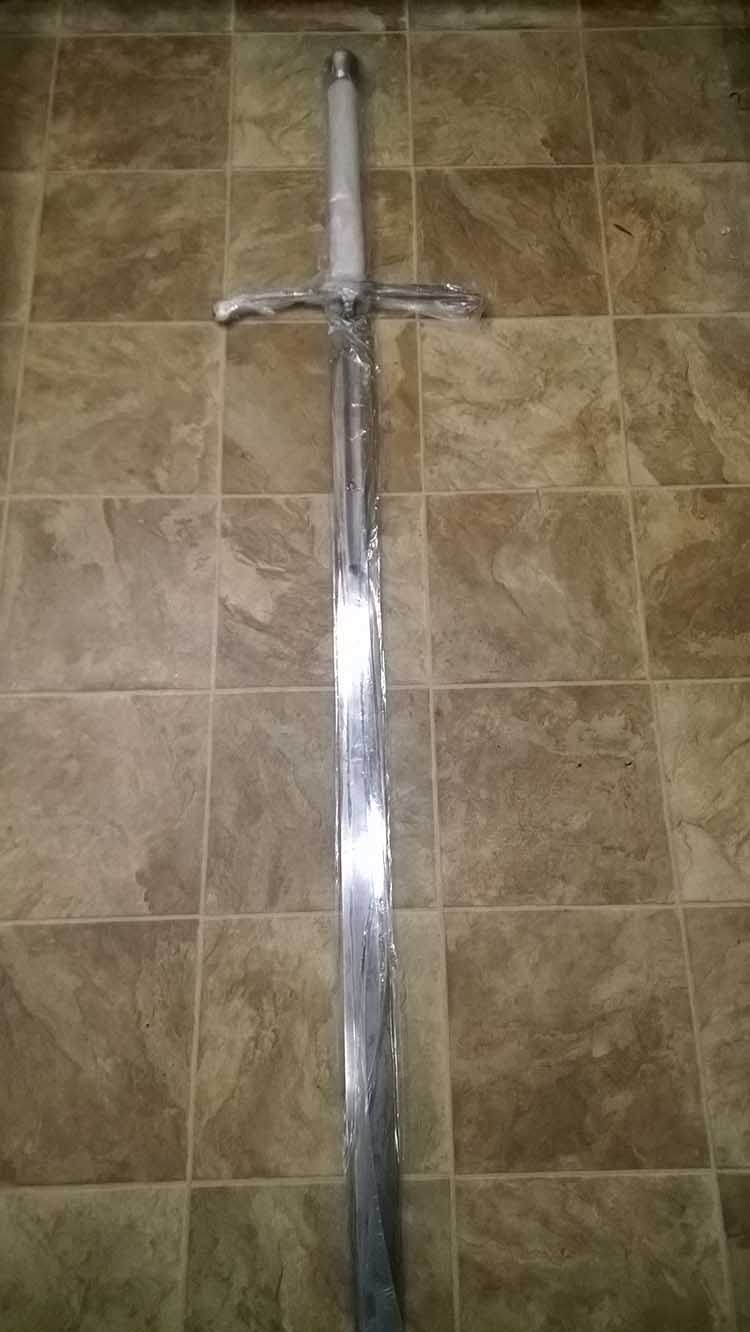
Statistics
- Blade Length: 47 1/2’’
- Handle Length: 13” 15 1/2” including the pommel
- Overall Length: 63 1/4”
- Guard Width: 13”
- POB (Point of Balance): 8”
- COP (Center of Percussion): 30” from the guard
- Weight: 6-6 1/2 lbs
The Blade
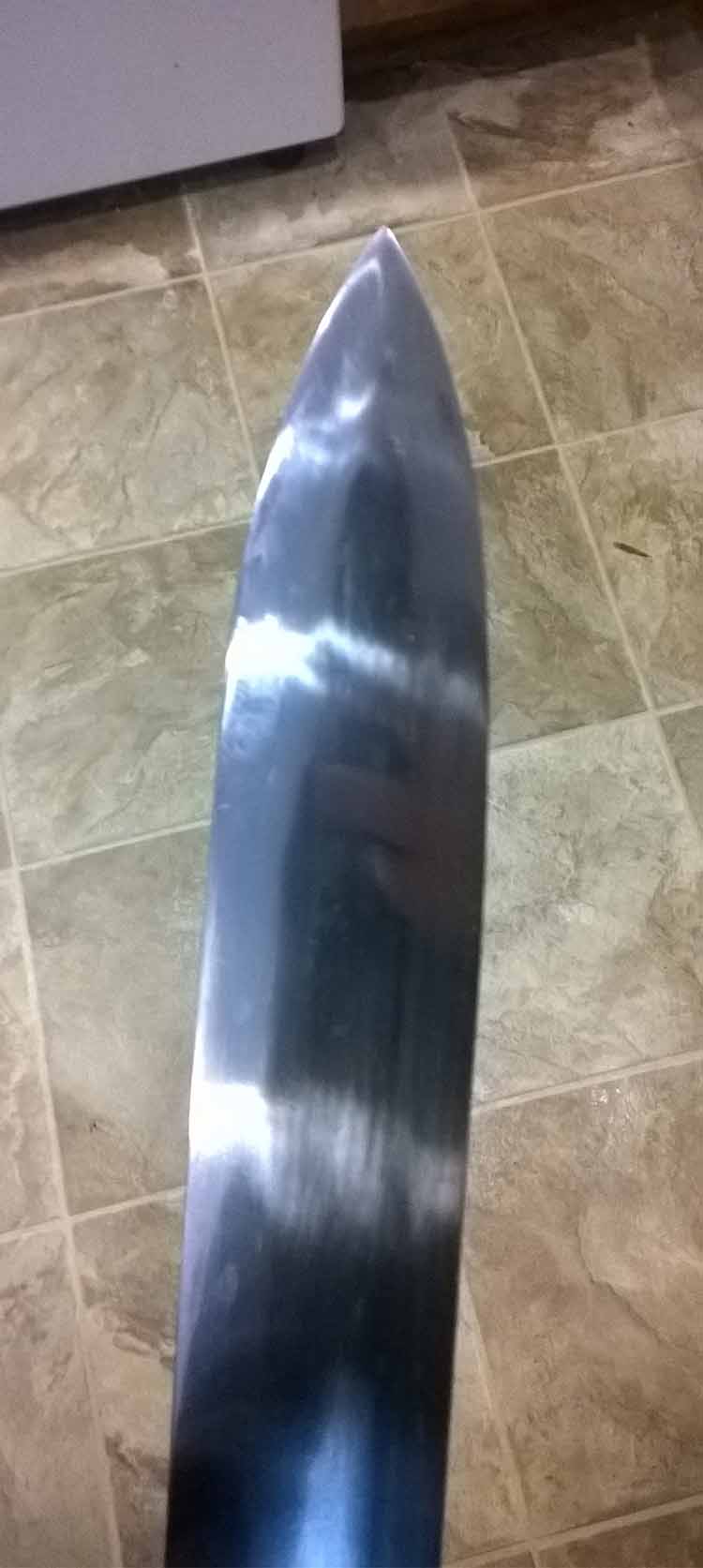
The blade is big. At 47 1/2” the blade is as big as my biggest sword, the Windlass Roven. The blade has a definite hexagonal profile with a wide fuller ending near the half of the blade. I’ve never handled a blade with this profile type but I can see why it was used to enhance a sword for cutting. Aesthetically its very eye catching and I like it. The blade has no taper and is the same profile along the whole length. There is also no riccasso even though most swords of this type had them.
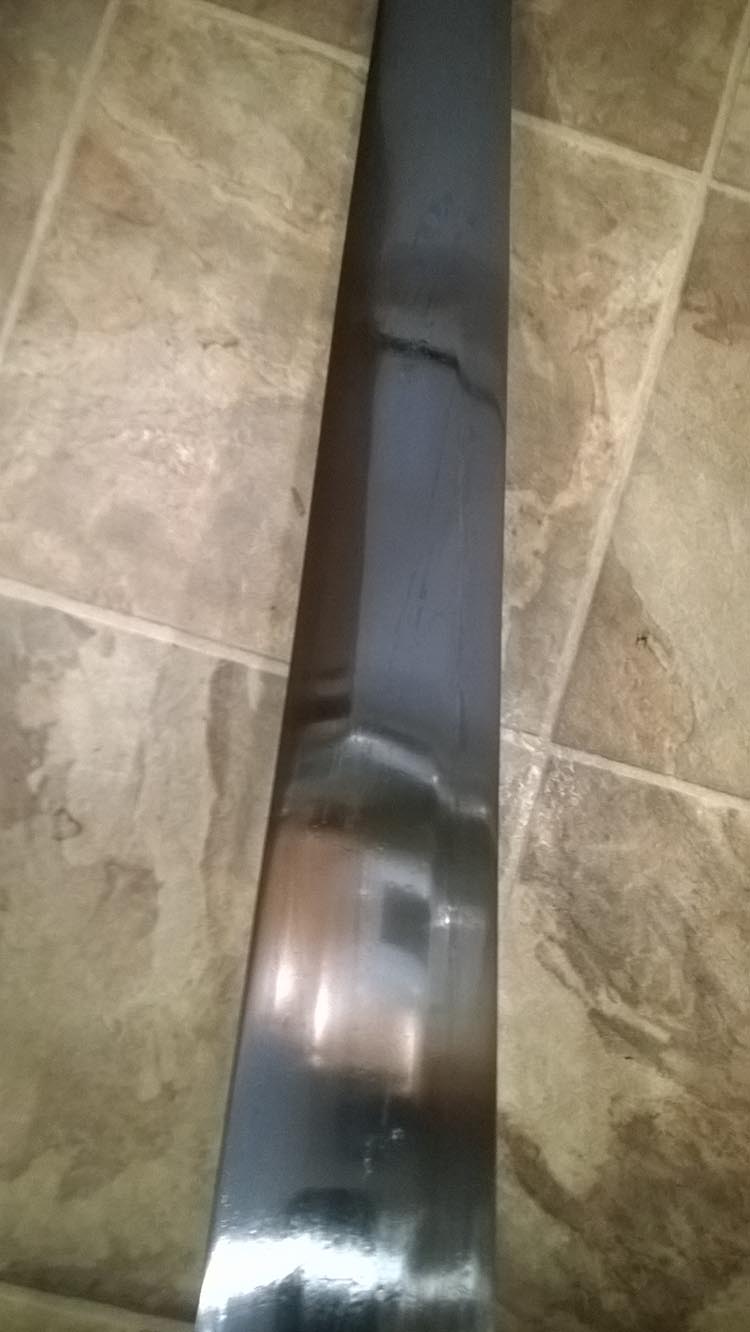
The blade does have a slight bow when held horizontally. Nothing drastic
but it’s there.
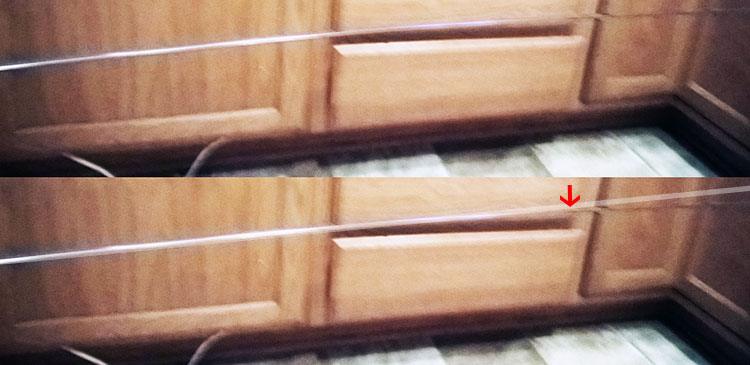 Second frame shows a white line where the blade should be if it was perfectly straight. Red arrow indicates where it begins to sag a little under its own size and weight.
Second frame shows a white line where the blade should be if it was perfectly straight. Red arrow indicates where it begins to sag a little under its own size and weight.The balance point seems high at 8” but honestly compared to a smaller sword the POB is right where this sword’s is. Just at a quarter length of the blade from the guard. The blade ends with an acute sort of spade shaped tip with a sharp point, well shaped with no blemishes. Overall the blade is well made, high polished (as is Windlass norm), nicely forged and heat treated. Historically I’d categorize this blade as a type XIX or XXII by its overall appearance.
The Handle
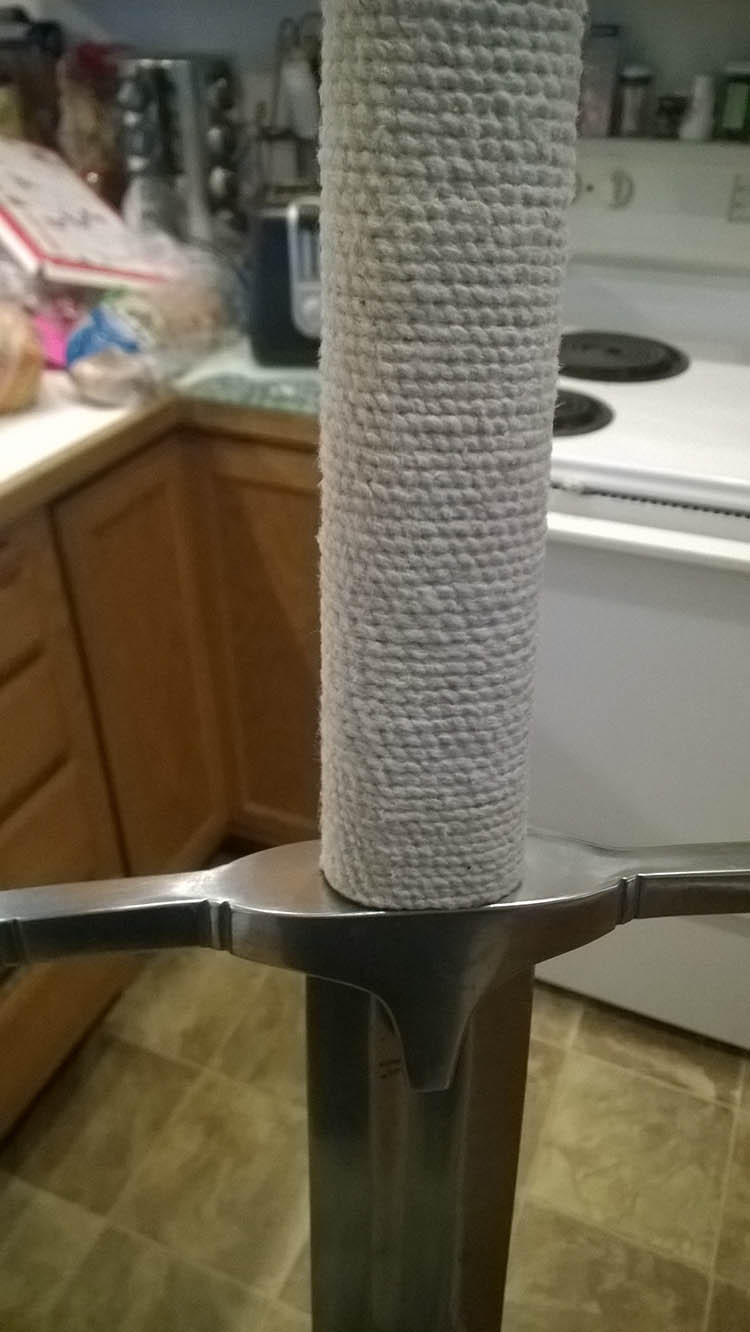
The handle is comfortable and even with a hardwood core and a hemp cord wrap. It long and serviceable allowing a wide two handed grip. The handle is oval at the base tapering down to a more rounded shape towards the pommel. The grip’s width is 4 1/2” at the guard, tapering to 3 1/2” where it meets the pommel. The wrap is a single piece of tightly woven hemp cord that has no spaces or movement. It appears to be wrapped underneath the pommel and possibly glued there to keep secure. It may not survive the elements of wet Scotland but it should survive my constant handling and it’s indoor home. Overall a comfortable well made handle with a slightly cheap alternative wrap to leather.
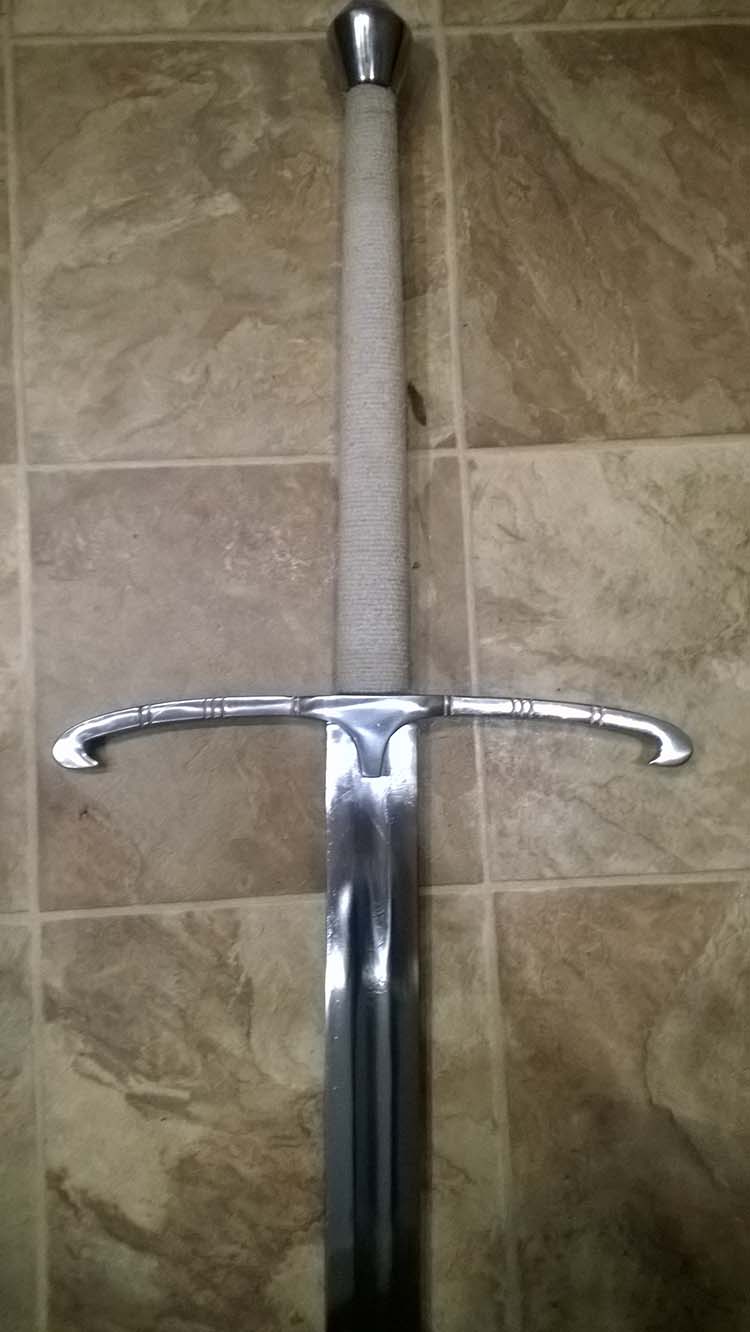
Like everything with this sword the guard is big. At 13” from quillion to quillion its quite wide and could easily keep any attacking weapon away. Or be used as a weapon in it’s own right if one used half-swording techniques. It is made of polished steel and is cast quite well. The guard face is about an inch long and an inch wide, with rounded edges and two upturned quillions cured towards the blade. There’s a casting mark underneath one of the quillions but its hidden well and doesn’t detract from the overall appearance of the sword. Towards the handle the guard slightly widens and ovals out where it meets the handle. The upper portion features a thick cusp that is about an 1 1/2” long. Overall a well made guard that is a good replica of the original.
The Pommel
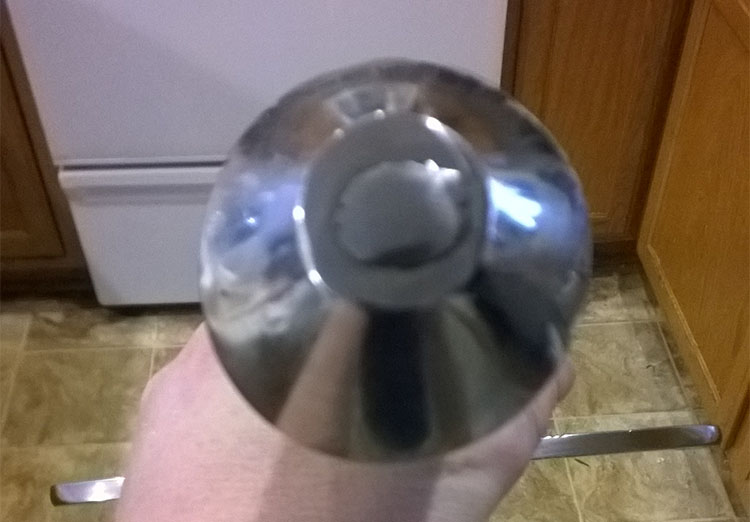
The pommel is a round onion bloom type. The pommel length is right at 2 1/2". Its smooth and cast well with no bumps or casting marks. Its solid and nicely peened to the handle. Overall an attractive additional piece of arsenal to this already imposing sword.
The Scabbard
This will be short because there is none. MRL described this sword as
being a type that was carried over the shoulder and normally didn’t have
one. Makes sense as that is historically accurate ( Even though the
Pavia has one...) and a sword of this size wouldn’t be drawn from the
hip. As a collector it would’ve been nice to have something to house it
in but overall nothing that I’m really missing too much.
Handling Characteristics
This is where the love and hate will come in. As I’ve been mentioning this is a big sword. If you’re expecting to handle it like a typical longsword, you’ll be in for a rude awakening.
This sword is meant to
cleave and hack and that’s how it handles. I can use it one-handed but
don’t expect any trick cutting from this sword. Pretty much center your
balance, hold your stance and give your opponent a moment to say their
prayers. The blade does whip quite a bit when I was doing some drills
and dry handling. I took it outside and took four big swipes with the
sword vertically, horizontally and diagonally left and right. The sword
whipped the most on the diagonal cuts and the least horizontally, with
the vertical cut having a some whip as well.
Overall the
balance point keeps this blade from being too blade heavy and someone
with the balance and strength could stop a cut midway. Being only three
inches taller than this sword myself, this sword probably isn’t the best
battlefield choice for me or someone of the same stature with less
strength than I posses (No I’m not He-Man but thanks to many years of
throwing 1/2 kegs of beer and weight lifting I’m pretty strong for my
size). Overall this sword handles like its meant to from what I’ve read.
A big hack and slash weapon meant to counter the horseman, lance and
spear while breaking the front lines. In the hands of someone with a
larger stature this sword would be almost unstoppable.
Test Cutting
No test cutting yet as the blade isn’t sharpened nor is the snow melted enough to give me a proper area. I’ll update this as soon as I am able, the way it’s warming up maybe at the end of the month. After dry handling I think it safe to say that this sword would be an decent cutter sharpened. Yes it has its light whip to it, but overall it has a good balance and control on the cut. Not sure if the whip in the blade would handle heavy targets but most Windlass swords tend to be light to medium cutters anyway.
Conclusion
Customize it like the Wallace Sword
Both Dave and another SBG member Demonskull who purchased this sword, both decided that they wanted to customize the handle to make it look more like the Wallace Sword on display in the Kelvingrove Museum.
If you want to learn how to customize a hilt like this, check out our tutorials here on how to leather wrap the handle and here on how to get the corded effect.
While they come unsharpened by default, you can either pay a nominal extra fee for the MRL sharpening service (about $16) or sharpen it up yourself using any of the techniques described in our article on sharpening swords here
Overall I must say I’m pretty impressed with the craftsmanship of this sword and it’s functional properties at it’s price range.
What I expected to be a heavy, clunky “boat anchor” as some put it. I found a decently balanced and sturdy two-handed sword.
It isn’t perfect but it isn’t a clunker either. It fits somewhere in the middle as most Windlass swords do compared to others on the market.
Being such a unique sword there isn’t much to compare it to outside the Hanwei Lowlander for exact type, the Hanwei Claymore, Gen2 Claymores or other Windlass two-hander variants. Overall this sword is unique and carries some great history with it.
If you want a big Greatsword, are looking for a historical replica of the Bruce/Wallace sword or just a functional Lowland Claymore, you can’t really go wrong with The Hero’s Warsword.
It has it’s imperfections as do all production models at this price range on the market, but it really shines in some of the presumed shady areas believed about this sword.
Compared to other swords of it’s type on the market it has its pros by having a full tang, peened construction, and keeping very accurate to it’s historical brethren.
With the usual cons
of a whippy blade, even though It was an issue the historical originals
tended to carry as well. It may not be a sword for everyone but then
again neither were the originals.
PROS
- Unique sword not found extensively on the market.
- Very accurate replica of the original for the price point.
- Well constructed with everything nice, tight and even.
- Forged blade with a nice polish, true profile to its type and even fullers.
- Long well carved handle allowing proper handling.
- Solid peen construction with a full tang.
CONS
- Blade slightly bows on it own weight.
- Quite whippy which could deter from cutting harder targets.
- Lack of a Riccasso found on most swords of this type for use in half-swording for blade reinforcement.
- Weight and size wont be for everyone.
- Lack of a scabbard for those who want to carry it sharpened or house the blade when in the house.
I hope this review of the Replica Wallace Sword has been helpful. To return to Affordable Replicas of Medieval Swords from Windlass Wallace Sword Replica - the Hero Warsword, click here

Buying Swords Online Can Be DANGEROUS!
Find the Best Swords in the:
Popular & Recommended ARTICLES

The ONLY true free online magazine for sword enthusiasts. Delivered once a month on the 1st day of the month, no filler and no BS, just the latest sword news & info delivered straight to your inbox.

